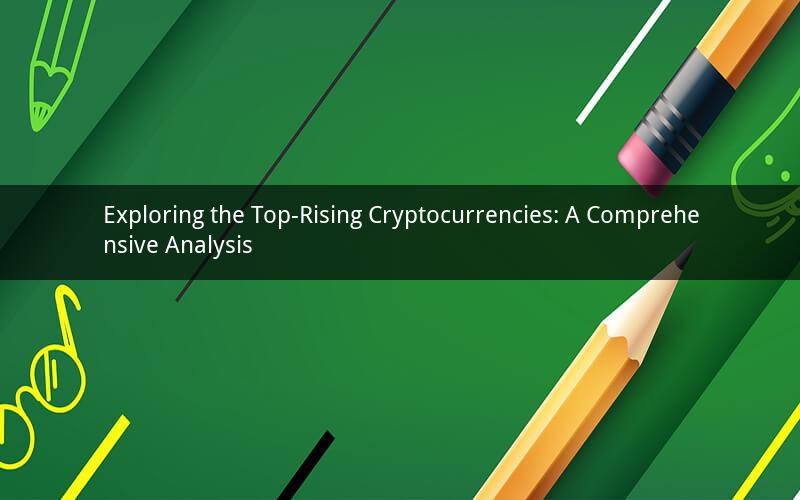
Introduction:
In the rapidly evolving world of cryptocurrencies, numerous digital assets have gained attention over the years. With their potential for high returns, many investors are keen to identify the top cryptocurrencies that are poised for significant growth. This article aims to delve into the most promising rising cryptocurrencies and provide insights into their potential for success.
1. Cardano (ADA)
Cardano is a blockchain platform that aims to offer a more sustainable and secure alternative to traditional blockchain technologies. Developed by Charles Hoskinson, the co-founder of Ethereum, Cardano is known for its innovative proof-of-stake algorithm, called Ouroboros. This algorithm aims to provide a more energy-efficient and scalable solution compared to the proof-of-work consensus mechanism used by Bitcoin and Ethereum. With its strong focus on sustainability and long-term viability, Cardano has gained significant traction among investors and enthusiasts alike.
2. Solana (SOL)
Solana is a high-performance blockchain platform that enables fast and low-cost transactions. It utilizes a unique consensus mechanism called Proof of History (PoH), which allows for faster block finality and reduces the need for mining. Solana's impressive transaction speed and low fees have made it a favorite among developers and investors. The platform's ability to handle high transaction volumes has also positioned it as a potential competitor to Ethereum in the decentralized finance (DeFi) space.
3. Binance Coin (BNB)
Binance Coin is the native token of the popular cryptocurrency exchange, Binance. Initially launched in 2017, BNB has grown to become one of the top cryptocurrencies by market capitalization. Binance Coin serves multiple purposes within the Binance ecosystem, including paying for transaction fees, participating in governance, and accessing exclusive services. The expansion of the Binance Smart Chain has further solidified its position as a versatile and valuable digital asset.
4. Polkadot (DOT)
Polkadot is a decentralized interoperability protocol that aims to connect multiple blockchains, enabling them to work together seamlessly. It introduces the concept of parachains, which are independent blockchains that can be connected to the Polkadot network. This innovative approach allows for enhanced scalability and interoperability, making Polkadot a promising project for the future. The platform has gained significant attention due to its potential to enable cross-chain DeFi applications and simplify the process of integrating different blockchains.
5. Chainlink (LINK)
Chainlink is a decentralized oracle network that connects smart contracts on the blockchain to real-world data and events. It plays a crucial role in providing reliable and secure off-chain data to smart contracts, enhancing their functionality. Chainlink has gained significant traction in the DeFi space, as it enables smart contracts to access real-world data, such as stock prices, weather information, or sports scores. Its ability to bridge the gap between blockchain and traditional systems has made it a valuable asset for developers and investors alike.
6. Terra (LUNA)
Terra is a blockchain platform that aims to provide a stable and scalable infrastructure for decentralized applications and financial services. The platform utilizes a unique algorithm called Liquidity Mining, which incentivizes users to lock their assets on the Terra network. This approach helps maintain the stability of the platform's native token, Terra (LUNA). Terra has gained significant attention due to its potential to disrupt the stablecoin market and facilitate seamless transactions across various applications.
7. Avalanche (AVAX)
Avalanche is a high-performance blockchain platform that focuses on scalability, security, and interoperability. It offers a unique consensus mechanism called Avalanche consensus, which enables rapid block finality and low transaction fees. Avalanche has gained attention for its ability to handle high transaction volumes, making it a potential competitor to Ethereum in the DeFi space. The platform's modular architecture also allows for easy integration of different protocols and applications.
FAQs:
1. What makes Cardano different from other blockchain platforms?
Cardano stands out due to its innovative proof-of-stake algorithm, Ouroboros, which provides a more energy-efficient and scalable solution. It also focuses on sustainability and long-term viability, making it a promising project for the future.
2. How does Solana's Proof of History mechanism work?
Solana's Proof of History mechanism allows for faster block finality by generating a cryptographic sequence that represents the order of events. This sequence is used to reach consensus and validate transactions, reducing the need for mining and enabling high transaction throughput.
3. What is the role of Binance Coin (BNB) in the Binance ecosystem?
Binance Coin serves multiple purposes within the Binance ecosystem, including paying for transaction fees, participating in governance, and accessing exclusive services. It has become a versatile and valuable digital asset due to its integration with the Binance platform.
4. How does Polkadot enable cross-chain interoperability?
Polkadot connects multiple blockchains through a unique interoperability protocol. It introduces the concept of parachains, which are independent blockchains that can be connected to the Polkadot network. This enables seamless communication and data exchange between different blockchains.
5. What are the key features of Chainlink's decentralized oracle network?
Chainlink's decentralized oracle network connects smart contracts on the blockchain to real-world data and events. It provides reliable and secure off-chain data, enabling smart contracts to interact with external systems and execute complex transactions.